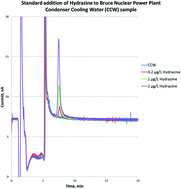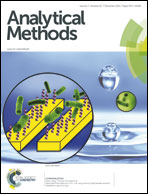Determination of hydrazine at Ontario nuclear power plants†
Abstract
In this study, we developed and validated a sensitive method for the determination of hydrazine in water samples using ion chromatography coupled with an amperometric detector (limit of detection (LOD) = 0.02 μg L−1 and limit of quantification (LOQ) = 0.1 μg L−1). Given the instability of hydrazine in the environment, we further investigated the optimal conditions for sample preservation and shipping. We found that 10 mmol L−1 hydrochloric acid preserves hydrazine at concentrations from 0.1 to 100 μg L−1. We then measured the concentration of hydrazine in water samples taken from Lake Huron near the Bruce Nuclear Power Plant (NPP) and from Lake Ontario near Pickering and Darlington NPPs. The concentrations of hydrazine in lake and condenser cooling water (CCW) samples (from <0.02 to 0.03 μg L−1), were similar to the background and verified with both field and cooler blanks. Our results demonstrate that measured concentrations of hydrazine in the CCW and in surface waters influenced by the NPPs are well below the Canadian Federal Environmental Quality Guideline of 2.6 μg L−1. The concentrations of hydrazine measured in service water samples from the three NPPs were in the range from 131 to 167 μg L−1, and represent the partial inventories of hydrazine in operating NPPs.


 Please wait while we load your content...
Please wait while we load your content...